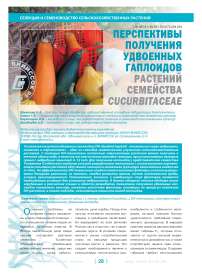Перспективы получения удвоенных гаплоидов растений семейства cucurbitaceae l
Автор: Шмыкова Н.А., Химич Г.А., Коротцева И.Б., Домблидес Е.А.
Журнал: Овощи России @vegetables
Рубрика: Селекция и семеноводство сельскохозяйственных растений
Статья в выпуске: 3-4 (28-29), 2015 года.
Бесплатный доступ
Технология получения удвоенных гаплоидов (DH (doubled haploid) - технологии) через андрогенез, гиногенез и партеногенез - один из способов генетического улучшения сельскохозяйственных растений. С помощью DH-технологии полностью гомозиготные растения можно получить в течение одного года, в отличие от классических методов селекции, при использовании которых процесс инбридинга занимает 6-12 лет. Для получения гаплоидов у представителей семейства Тыквенные (Curbitaceae) наиболее успешно разработаны технологии с использованием партеногенеза (опыление растений облученной пыльцой) и гиногенеза (культура неопыленных семяпочек in vitro). На эффективность DH-технологии влияют многочисленные факторы: условия выращивания донорных растений, их генотип, стадия развития мешка, состав питательной среды, условия культивирования. Оптимальное значение и комбинация этих факторов являются необходимым условием для успешного эмбриогенеза. В данной обзорной статье обобщен опыт зарубежных и российских ученых в области разработки технологии получения удвоенных гаплоидов тыквенных культур, показаны различные факторы, влияющие на процессы получения DH-растений, а также подходы, позволяющие повысить выход гаплоидов.
Огурец (cucumis sativus l.), тыква, кабачок (cucurbita l.), dh-технологии, культура неопыленных семяпочек, эмбриогенез, удвоенные гаплоиды
Короткий адрес: https://sciup.org/14025157
IDR: 14025157 | УДК: 635.61/.63:631.523:575.224.234
Текст научной статьи Перспективы получения удвоенных гаплоидов растений семейства cucurbitaceae l
О сновные проблемы, на решение которых направлены усилия современной селекции – это полноценное питание людей, их здоровье, источники энергии. В России значительную долю среди овощей составляют растения семейства Тыквенные
(Cucurbitaceae). Наибольшее хозяйственное значение среди них имеют огурец, тыква, кабачок, патиссон, дыня и арбуз. Плоды этих культур отличаются высокими вкусовыми и целебными свойствами. Их выращивают во всех регионах России, как в открытом, так и защищенном грунте. В условиях современного рынка потребительский спрос на овощную продукцию постоянно растет и меняется. Это создает необходимость наличия у селекционера генотипически раз- нообразного и стабильного материала, который позволит быстро удовлетворять требования современного производства. В мировой практике широкое распространение имеют гибриды F1, которые отличаются от сортов высокой вырав-ненностью и урожайностью, а также способствуют защите прав селекционеров и семеноводов. Создание гибридов требует использования

Рис.1. Получение DH-растений огурца в культуре неопыленных семяпочек. Прорастание семяпочки на среде МСм с 0,2 мг/л ter ТДЗ и 0,0001 мкМ эпибрассинолида (А). Развитие саженцев на без гормональной среде MС (Б). DH-растения огурца (В).
гомозиготных родительских линий, получение которых традиционными методами трудоемкое и длительное (6-8 лет), что сильно тормозит селекционный процесс.
Для решения этой проблемы большое значение имеет альтернативный метод создания гомозиготных линий из удвоенных гаплоидов (DH – doubled haploid). Из трех известных способов получения гаплоидов (андрогенез, гиногенез и партеногенез) у тыквенных культур наиболее успешно используется партеногенез.
По данным зарубежных исследователей с помощью партеногенеза можно получить 3-13 гаплоидов огурца на 1000 семян (Troung-Andre, 1988; Sauton, 1989; Przyborowski, Niemirowicz-Szczytt 1994; Caglar, Abak, 1999; Faris, Niemirowicz-Szczytt, 1999; Claveria et al., 2005; Xie et al., 2005). Для индукции партеногенеза у огурца, как правило, используют опыление женских цветков γ-облученной пыльцой с последующим выделением гаплоидных зародышей. Индуцированный партеногенез также широко применяют при получении гаплоидов у другого представителя рода Cucumis – дыни (Ficcadenti et al., 1995; Taner et al., 2000; Lotfi et al., 2003; Sun et al., 2006; Lim, Earle, 2009).
Отличие гиногенеза от партеногенеза заключается в том, что культивируются in vitro неопыленные завязи (фрагменты завязей) или семяпочки на искусственных питательных средах. Получение гаплоидных растений в культуре неопы-ленных семяпочек является результатом перехода клеток зародышевого мешка с гаметофитного пути развития на спорофитный с образованием из них эмбриоидов или морфогенного каллуса. На процесс индукции гиногенеза влияет большое число факторов таких, как генотип растения, стадия развития женского гаметофита, состав питательных сред, условия выращивания донорных растений, поэтому исследования в области гиногенеза сосредоточены на изучении их влияния на выход DH-растений. По литературным данным эффективность этих технологий следующая:
из 300 завязей огурца получается 240 эмбриоидов US Patent 5492827 (Dirk R., 1996); из 100 завязей – эмбриоидов (Gemes Juhans et

2002). Если учитывать, что в завязи огурца содержится 400-650 семяпочек в зависимости от сорта, то число получаемых DH-растений несколько меньше, чем при партеногенезе. В зарубежных селекцион- ных фирмах, несмотря на небольшой выход DH-растений, такого типа технологии позволяют получать их в промышленных масштабах (Dirk, 1996).
Поиски способов повышения выхода DH-растений в культуре неопыленных семяпочек проводятся учеными разных стран. Li с коллегами (2013) показали, что добавления нитрата серебра в питательную среду в концентрации 5-10 мг/л способствует побегообразованию у культивируемых семяпочек.
Во ВНИИ селекции и семеноводства разработана отечественная конкурентоспособная технология получения DH-линий огурца в культуре неопыленных семяпочек in vitro (рис. 1) (Шмыкова, Супрунова, 2009).
1. Регенерация растений огурца из неопыленных семяпочек огурца, культивируемых на модифицированной среде СВМ с тидиазуроном и эпибрассинолидом
|
Сортообразец |
Число культивируемых семяпочек/завязей |
Число семяпочек, образовавших растение |
Число растений, полученных из одной завязи |
|
№3 |
2571 (10) |
80 |
8,0 ± 2,4 |
|
№7 |
2593 (10) |
30 |
3,0 ± 1,1 |
|
№13 |
2342 (10) |
200 |
20,0 ± 4,6 |
|
№24 |
2601 (10) |
60 |
6,0 ± 1,9 |

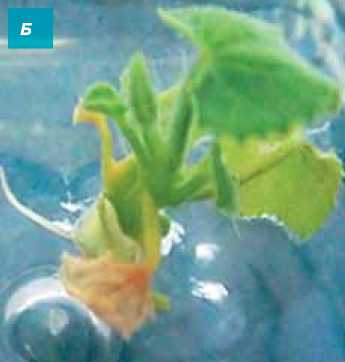
.2. Получение DH – растений тыквы в культуре неопыленных семяпочек.
растание семяпочки на среде МСм с 0,2 мг/л ТДЗ и 0,0001 мкМ эпибрассино-лида (А). Развитие проростка гибрида № 100 на без гормональной среде MС (Б).
Применение для индукции гиноге-^э неза 0,2 мг/л тидиазурона в сочетании с 0,0001 мкМ эпибрассинолида позволило повысить регенерационную способность семяпочек. Полученные результаты превышали данные эксперимента, проведенного по методике Gemes Juhans с коллегами (2002) в несколько раз (3-20 раз в зависимости от образца) (табл. 1).
Вторым представителем семейства Тыквенные, имеющим большое хозяйственное значение, является род Cucurbita L. Для получения DH-растений различных представителей этого рода широко применяют партеногенез (Kurtar, 1999, 2009; Kurtar et al., 2002, Kurtar et al., 2009, Kurtar et al., 2010). Metwally с коллегами (1998a) и Shalaby (2007) сообщили об успешном использовании культуры неопыленных семяпочек тыквы.
Во ВНИИ селекции и семеновод- ства проведены успешные исследования по получению DH-растений у представителей рода Cucurbita через культуру неопыленных семяпочек (рис. 2). Донорные растения были представлены гибридами тыквы №100, 103, 104 и 112. Выделенные из завязей бутонов семяпочки помещали на питательную среду с минеральной основой МСм (Matsuda et al., 1984) с добавлением аминокислот (100мг/л пролина, 100 мг/л серина и 800 мг/л глутамина и витаминов по прописи NLN (Lichter, 1982), 30 г/л сахарозы, 7 г/л агара. Для индукции гиногенеза использовали два варианта регуляторов роста: первый вариант – 0,2 мг/л тидиазурона и 0,0001 мкМ эпи-брассинолида, второй – 2,0 мг/л 2,4Д.
Гибриды тыквы различались по частоте индукции гиногенеза в зависимости от варианта среды. У гибрида №100 индукция гиногенеза происходила лишь на среде с 0,2 мг/л тидиазурона и 0,0001 мкМ эпибрас-синолида, а у гибридов №103 и №112 – на среде с 2,0 мг/л 2,4Д, а гибриды №103 и №104 давали хороший результат на обеих средах. Максимальное число эмбриоидов, образовавшихся из одной завязи, было у гибрида №112 (9 штук), также хорошие результаты получены у гибрида №104 (6-7 штук эмбриоидов из одной завязи).
Культивирование семяпочек кабачка проводили на среде того же состава, что и тыквы. В опытах использовали 6 сортобразцов. Число вариантов индукционных сред было увеличено до 5. Они различались по содержанию регуляторов роста: 1 – 0,1 мг/л тидиазурона; 2 – 0,2 мг/л тидиазурона; 3 – 1,0 мг/л 2,4 Д; 4 – 2,0 мг/л 2,4 Д; 5 – 1,0 мг/л 2,4 Д и 1,0 мг/л кинетина. Сортобразцы проявили различную отзывчивость к индукции гиногенеза. Например, у образца №1 только одна неопылен-ная семяпочка проросла из 1220 штук культивируемых семяпочек. У самого отзывчивого сортообразца проросло 69 штук семяпочек из 1180 культивируемых. Эффективнее индукция гиногенеза происходила на средах с 1,0 мг/л 2,4 Д и 2,0 мг/л 2,4Д.
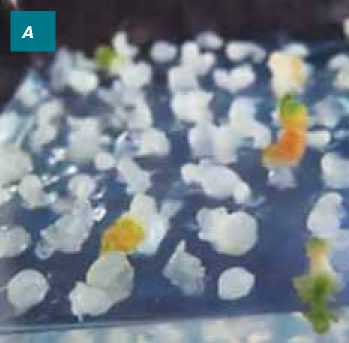
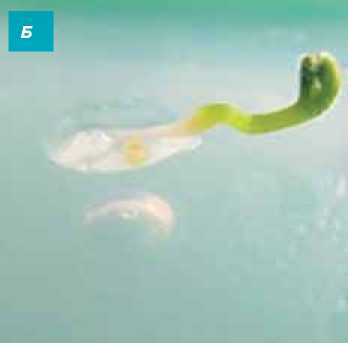
Б
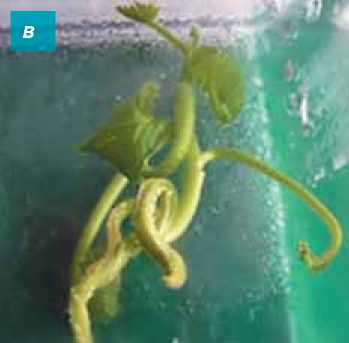
Рис. 3. Получение DH – растений кабачка в культуре неопыленных семяпочек. А – прорастание семяпочек кабачка сортообра-зеца №2 на индукционной среде МСм с 1,0 мг/л 2,4 Д. Б – развитие проростка на безгормональной среде МС. В – развитие растения регенеранта на безгормональной среде МС.
Анализ зарубежного и отечественного опыта показывает перспективность разработок DH-технологий получения удвоенных гаплоидов у растений семейства Тыквенные через культуру неопыленных семяпочек in vitro, внедрение которых в селекционный процесс позволит ускорить создание отечественных, конкурентоспособных гибридов огурца, тыквы, кабачка.
Наряду с гиногенезом встречаются единичные сообщения о положи- тельных результатах при культивировании in vitro пыльников растений рода Cucurbita (Metwally et al., 1998b; Mohamed, Refaei, 2004;). В послед- нее десятилетие также активизировались исследования в культуре пыльников огурца (Kumar et al., 2003, 2004; Song et al., 2007). Однако, при культивировании пыльников огурца, как показали наши исследования, происходит образование каллуса из соматических тканей стенок пыльника и связника (Suprunova, Shmykova, 2008). Это усложняет отбор истин- ных
удвоенных
гаплоидов.
Результативных исследований культуры микроспор in vitro тыквенных культур на сегодняшний день нет, хотя именно это направление исследований является более привлекательным.
PROSPECTIVE OF DEVELOPMENT OF DOUBLED HAPLOID PLANTS OF CUCURBITACEAE FAMILY
Shmykova N.A., Khimich G.A., Korotseva I.B., Domblides E.A.
Federal State Budgetary Scientific Research Institution
«All-Russian Scientific Research Institute of vegetable breeding and seed production»
143080, Russia, Moscow region, Odintsovo district, p. VNIISSOK, Selectionnaya street, 14
Список литературы Перспективы получения удвоенных гаплоидов растений семейства cucurbitaceae l
- Шмыкова Н.А., Супрунова Т.П. Индукция гиногенеза в культуре in vitro неопыленных семяпочек Cucumis sativus L.//Гавриш -2009. -№4. -С.40-44.
- Caylar G., Abak K. 1999. Progress in the production of haploid embryos, plant and double haploids in cucumber (C. sativus L.) by gamma irradiated pollen in Turkey. Acta Hort. Vol. 492. P. 317-322.
- Claveria E., Garcia-Mas J., Dolcet-Sanjuan R. 2005. Optimization of cucumber doubled haploid line production using in vitro rescue of in vivo induced parthenogenic embryos. J. Amer. Hort. Sci. Vol. 130(4). P. 555-560.
- Dirk R. US Patent 5492827 -Metod for the production of double-gaploid cucumbers -1996.
- Faris N.M., Niemirowicz-Szczytt K. 1999. Cucumber (Cucumis sativus L.) embryo development in situ after pollination with irradiated pollen. Acta Biologica Cracoviensia. Vol. 41. P. 111-118.
- Ficcadenti N., Veronose P., Sesuli S. et al. Influence of genotype on induction of haploidy in Cucumis melo L. by using irradiated pollen. J. Genet Breed.1995. Vol. 49. P.-359-364.
- Gemes-Juhasz A., Balogh P., Ferenczy A., Kristof Z. 2002. Effect of optimal stage of female gametophyte and heat treatment on in vitro Gynogenesis induction in cucumber (Cucumis sativus L.). Plant Cell Rep. Vol. 21. P. 105
- Kumar H.J.A., Murthy H.N. 2004. Effect of sugars and aminoacids on androgenesis of Cucumis sativus. Plant Cell Tiss. Org. Cult. Vol. 78. P. 201-208 Kumar H.J.A., Murthy H.N., Pack K.J. 2003. Embryogenesis and plant regeneration from anther cultures of Cucumis sativus L. Scientia Hort. Vol. 447. P. 623-624.
- Kurtar E.S, Balkaya A. Production of in vitro haploid plants from in situ induced haploid embryos in winter squash (Cucurbita maxima Duchesne ex. Lam) via irradiated pollen. Plant Cell Tiss. Organ Cult. 2010. DOI 10. 1007/s11240-010-9729-1.
- Kurtar E.S. Influence of gamma irradiated pollen viability, germinability and fruit and seed-set of pumpkin and winter squash. Afr J Bio. 2009. 8. P. 69186926.
- Kurtar E.S. Research on the effects of genotypes and growing seasons on in situ haploid embryo induction and in vitro plant obtention via irradiated pollen in squash. PhD Thesis, University of Cukurova, 1999.
- Kurtar E.S., Balkaya A., Ozbakir M., Ofluoglu T. Induction of haploid embryo and plant regeneration via irradiated pollen technique in pumpkin (Cucurbita moschata Duchesne ex. Poir). Afr J Bio. 2009. 8. P. 5944-5951.
- Kurtar E.S., Sari N., Abak K. Obtention of haploid embryo and plants through irradiated pollen technique in squash (Cucurbita pepo L.). Euphytica. 2002. Vol. 127. P. 335-344.
- Li J.W., Si S.W., Cheng J.Y., Li J.X., Liu J.Q. Thidiazuron and silver nitrate enhanced gynogenesis of unfertilized ovule cultures of Cucumis sativus//Biologia Plantarum 2013. V. 57. P. 164-168.
- Lichter R. Induction of haploid plants from isolated pollen of Brassica napus.//Z. Pflanzenphysiol., 1982. V. 105. P. 427 -434
- Lim W., Earle E.D. Enhanced recovery of doubled haploid lines from parthenogenetic plants of melon (Cucumis melo L.). Plant Cell Rep. 2009. Vol. 98. P. 351-356.
- Lotfi M., Alan A.R., Henning M.J., Jahn M.M., Earle E.D. Production of haploid and doubled haploid plants of melon (Cucumis melo L.). for use in breeding for multiple virus resistance. Plant Cell Rep. 2003. Vol. 21. P. 11211128.
- Masuda K.,Kikuta Y., Okazava Y.A. Revision of the medium for somatic embryogenesis in carrot suspension culture//J. Fac. Agr. Hokkaido Univ. 1981. V. 60. P. 183-193.
- Metwally E. A., Moustafa S.A., El-Sawy B.I., Haroun S.A., Shalaby T.A. Production of haploid from in vitro culture of unpollinated ovules of Cucurbita pepo. Plant Cell Tiss. Organ Cult. 1998a. Vol. 52. P. 117-121.
- Metwally E. A., Moustafa S.A., El-Sawy B.I., Haroun S.A., Shalaby T.A. Haploid plantlets derived by anther culture of Cucurbita pepo. Plant Cell Tiss. Organ Cult. 1998b. Vol. 52. P. 171-176.
- Mohamed M.F., Refaei E.F.S. Enhanced haploid regeneration in anther culture of summer squash Cucurbita pepo L., Cucurbit Genetics Cooperative Report. 2004. Vol. 27. P.57-60.
- Przyborowski J., Niemirowicz-Szczytt K. Main factors affecting cucumber (Cucumis sativus L.) haploid embryo development and haploid plant characteristics.//Plant Breed 1994. V. 112. P. 70-75.
- Sauton A. Haploid gynogenesis in Cucumis sativus induced by irradiated pollen. Cucurbit Genetics Cooperative Report 1989. Vol. 12. P. 22-23.
- Shalaby T. A. Factors affecting haploid induction through in vitro gynogenesis in summer squash (Cucurbita pepo L.)//Scientia Horticulturae 2007. V. 115. P. 1-6
- Song H., Lou Q.-F., Luo X.-D., Joseph N. Wolukau J. N., Diao W.-P., Qian C.-T., Jin-Feng Chen J.-F. Regeneration of doubled haploid plants by androgenesis of cucumber (Cucumis sativus L.)//Plant Cell Tiss Organ Cult 2007. V. 90. P. 245-254.
- Sun Y., Mei S., Peng J.et al. Induced haploid plants after pollination by irradiated pollen in Cucumis melo L. Hubei Agr Sci. 2006. Vol. 4. P. 98-100. Suprunova T., Shmykova N. In vitro induction of haploid plants in unpollinated ovules, anther and microspore culture of Cucumis sativus//Cucurbitaceae 2008. Proceedings of the IXth EUCARPIA meeting on genetics and breeding of Cucurbitaceae. 21-24 may 2008 Avignon, France. P. 371-374.
- Taner K.Y., Yanmaz R., Kunter B. The effects of irradiation dose and harvest period on haploid plant formation via irradiated pollen in snake cucumber (Cucumber melo var flexuosus Naud.) IIIrd National Vegetable Culture Symp. Isparta-Turkey. 2000. P. 177-181.
- Troung-Andre I In vitro haploid plants derived from pollination by irradiated pollen of cucumber. Proc. Eucarpia Mett Cucurbit. Avignon-Monfavet. France. 1988. P. 143-144.
- Xie M., Zhao J., He H., Wu A., Cai R. Induced haploid plants after pollination by irradiated pollen in Cucumis sativus L. J. Shanghai Jiaotong Univ (Agr sci). 2005. N2. P.45-49.

